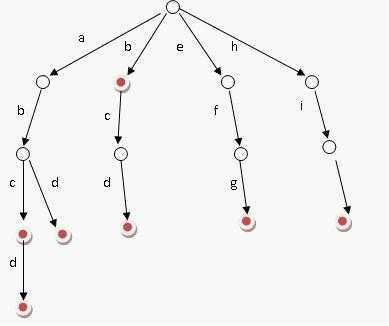标签:
字典树(trie树)
字典树是一种在字符串查找,前缀匹配等方面应用广泛的算法,它在查找字符串时只与被查询的字符串长度有关,所以它在查找时只有O(1)的时间复杂度,但随之而来的较大的空间复杂度。
一.原理分析

如图,字典树的每一个节点是由一个数据域(用来标记是否在此处有字符串终止)与26个指针域(表示26个小写字母)组成(PS:联想链表)。每个节点表示一个字符,我们将我们将要输入的字符串插入字典树中,从根节点到某一节点(具有终止标记,上图红点),为已插入字符串,上图中的字符串有:abc、abcd、abd、b、bcd、efg、hig(图片转载字百度图片)。
二.分步实现
1.trie树结构体定义
1 struct node 2 { 3 bool k; 4 node *next[26]; //定义的字典树为只有26个小写字母,可增加减少
5 node() 6 { 7 int i; 8 for(i=0; i<26; i++) 9 next[i] = NULL; 10 k = false; 11 } 12 ~node() 13 { 14 int i; 15 for(i=0;i<26;i++) 16 { 17 if(next[i]!=NULL) 18 { 19 delete next[i]; 20 } 21 } 22 } 23 }; 24 node *head;
PS:被注释掉部分是用构造函数初始化节点与使用析构函数删除节点。
上图代码中的next[26]表示每个节点的下一层节点数量,小写字母为26,加上大写就是52,加上数字就是62,以此类推。而bool型的K则表示该位置是否有终止标记,可根据题意改变为其他标记。
2.字典树的插入
1 void insert_ch(char *ch) 2 { 3 int i; 4 node *p=head; 5 for(i=0; ch[i]; i++) 6 { 7 if(p->next[ch[i]-‘a‘] == NULL) //判断下层节点是否存在 8 p->next[ch[i]-‘a‘] = new node; //开辟新空间 9 p = p->next[ch[i]-‘a‘]; //向下一层进行拓展 10 } 11 p -> k = true; //进行字符串结尾标记 12 }
每次从根节点进行插入,如果向下的节点已经存在,就直接读取,否则拓展一个新节点。之后将最后一个节点的k标记为true表示该位置有一个字符串结尾。
3.字符串查找
1 bool find_ch(char *ch) 2 { 3 int i; 4 node *p=head; 5 for(i=0; ch[i]; i++) 6 { 7 if(p->next[ch[i]-‘a‘]==NULL) 8 return false; 9 p = p -> next[ch[i]-‘a‘]; 10 } 11 return p -> k; 12 }
基本过程与插入相同,向下查找,入过该节点不存在,直接返回false,如果存在一直向下查找,最终返回末尾标记的k。
1.模板代码
1 #include<algorithm> 2 #include<iostream> 3 #include<cstdio> 4 #include<cmath> 5 #include<cstring> 6 using namespace std; 7 struct node 8 { 9 bool k; 10 node *next[26]; 11 node() 12 { 13 int i; 14 for(i=0;i<26;i++) 15 { 16 next[i]=NULL; 17 k=false; 18 } 19 } 20 ~node() 21 { 22 int i; 23 for(i=0;i<26;i++) 24 { 25 if(next[i] != NULL) 26 delete next[i]; 27 } 28 29 } 30 }; 31 node *head; 32 void insert_ch(char *ch) 33 { 34 int i; 35 node *p = head; 36 for(i=0;ch[i];i++) 37 { 38 if(p -> next[ch[i]-‘a‘ ] == NULL) 39 p -> next[ch[i]-‘a‘ ] = new node; 40 p = p -> next[ch[i]-‘a‘ ]; 41 } 42 p -> k = true; 43 } 44 bool find_ch(char *ch) 45 { 46 int i; 47 node *p = head; 48 for(i=0;ch[i];i++) 49 { 50 if(p -> next[ch[i]-‘a‘ ] == NULL) 51 return false; 52 p = p -> next[ch[i]-‘a‘ ]; 53 } 54 return p -> k; 55 } 56 char ch[100]; 57 int main() 58 { 59 head = new node; 60 while(~scanf("%s",ch)) 61 insert_ch(ch); 62 while(~scanf("%s",ch)) 63 printf("%s\n",find_ch(ch) ? "YES" : "NO"); 64 delete head; //删除节点 65 return 0; 66 }
三.另一种实现方式
动态分配内存对空间掌控很好,用一个节点开辟一个节点,但是在做题中有时会出现大大小小的问题不好结决,所以可以选择另一种方法,直接开辟出一个很大的结构体数组用来保存节点,不用考虑开辟与删除节点问题。
1 #include<algorithm> 2 #include<iostream> 3 #include<cstdio> 4 #include<cmath> 5 #include<cstring> 6 using namespace std; 7 struct node 8 { 9 bool k; 10 node *next[26]; 11 }; 12 node no[10000000],*head; 13 int iii; 14 node *new_node() 15 { 16 int i; 17 node *p=&no[iii++]; 18 for(i=0;i<26;i++) 19 { 20 p -> next[i] = NULL; 21 } 22 p -> k = false; 23 } 24 void insert_ch(char *ch) 25 { 26 int i; 27 node *p=head,*t; 28 for(i=0; ch[i] ;i++ ) 29 { 30 if(p->next[ch[i]-‘a‘]==NULL) 31 { 32 t=new_node(); 33 p->next[ch[i]-‘a‘]=t; 34 } 35 p = p->next[ch[i]-‘a‘]; 36 } 37 p -> k = true; 38 } 39 bool find_ch(char ch[]) 40 { 41 int i; 42 node *p=head; 43 for(i=0;i<ch[i];i++) 44 { 45 if(p->next[ch[i]-‘a‘]==NULL) 46 return false; 47 p = p -> next[ch[i]-‘a‘]; 48 } 49 return p -> k; 50 } 51 int main() 52 { 53 char s[100]; 54 int i,n; 55 head = new_node(); 56 while(~scanf("%d",&n)) 57 { 58 iii=0; 59 for(i=0;i<n;i++) 60 { 61 scanf("%s",s); 62 insert_ch(s); 63 } 64 scanf("%d",&n); 65 for(i=0;i<n;i++) 66 { 67 scanf("%s",s); 68 printf("%s\n",find_ch(s) ? "YES" : "NO"); 69 } 70 } 71 return 0; 72 }
这种方法与上面的基本相同,只是节点不在用new开辟,而是直接从结构体数组中取用,这种方法的弊端节点有最大值,当需要保存的数据量过大时,会数组越界。保存数据量小时对空间的浪费也很严重。
四.相关基础题目
HDOJ 1251 统计难题:
http://acm.hdu.edu.cn/showproblem.php?pid=1251
HDOJ 1671 Phone List:
http://acm.hdu.edu.cn/showproblem.php?pid=1671 //用第一种方法记得释放空间,否则超内存
HDOJ 1247 Hat’s Words:
http://acm.hdu.edu.cn/showproblem.php?pid=1247
PS:本贴纯手打,如打码有问题请各位大牛指正,谢谢大家~
欢迎大家转载哦~请于此处注明出处:http://www.cnblogs.com/zhuyuan/
标签:
原文地址:http://www.cnblogs.com/zhuyuan/p/4261268.html